
Documentary short movie, 31 minutes

The Ojai Mardi Gras, 'OMG,' is an annual charity ball in Ojai, California. A 'child' of the New Orleans Mardi Gras, the OMG has its own flair and yearly theme. 2013 marks the 23rd OMG, with 'Burning Desire' as the theme.
The origin of the OMG is a moving tribute to the power of love and friendship, bringing together a community to celebrate their lives. Our story chronicles how this event came to Ojai, as well as following this year's party.
Life is a gift. As busy adults, we seldom stop to realize just how precious this gift is. The loss of a loved-one usually causes everyone to remember that life truly is a gift. Each year in Ojai, California, a group of musicians gather and host a killer party under the Mardi Gras banner to play music and remember one of their own, Lyle Mathews.
Currenly in Development
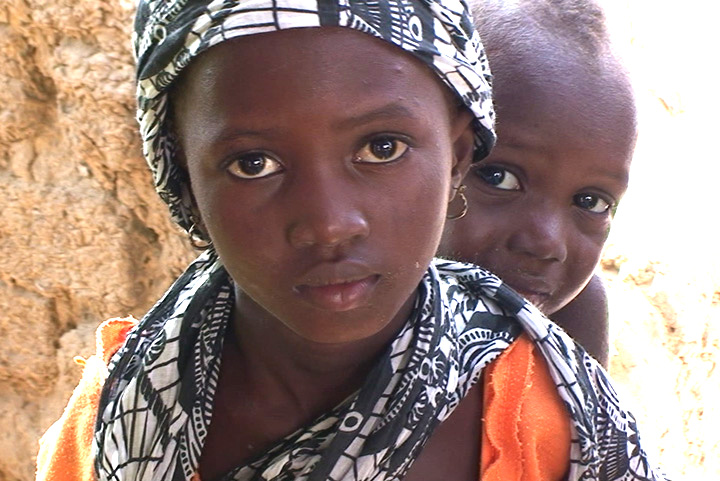
Kids from Handaga Village, near Tera, Tillabery Region, Niger
A LITTLE SCHOOL IN AFRICA will follow the impact of THE NIGER SCHOOL PROJECT, an agriculture-oriented tutorial educational facility built and operated in one of the most disadvantaged countries of the world, Niger. This feature-length documentary has been approved by the International Documentary Association's (IDA) Fiscal Sponsorship program.
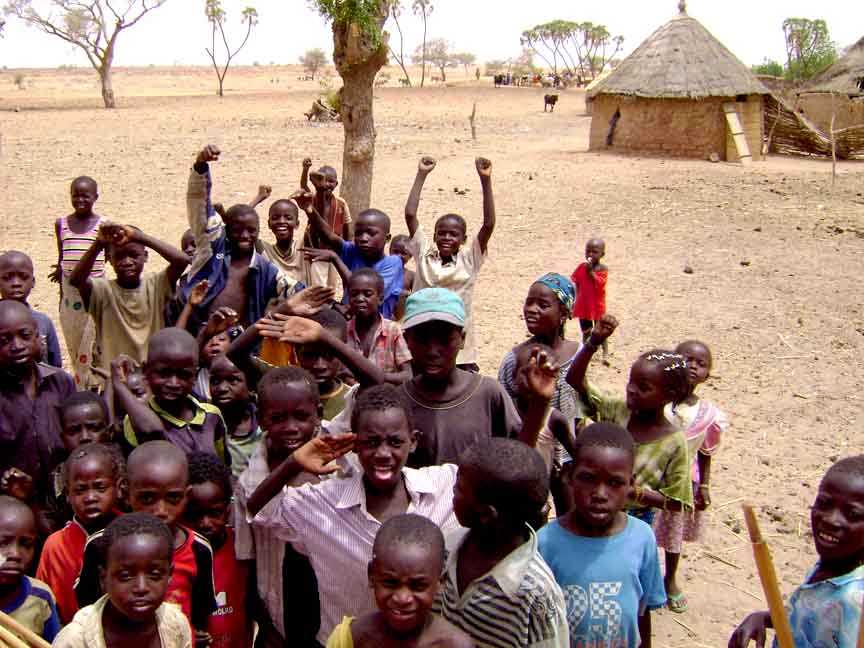
Children in Babousaye Village, Niger
NIGER is one of the poorest and least developed countries in the world, with over 80% of its territory covered by the Sahara Desert, and much of the rest threatened by periodic drought and desertification. The economy is concentrated around subsistence and some export agriculture clustered in the more fertile south, and the export of raw materials—especially uranium ore. Niger remains handicapped by its landlocked position, poor education, infrastructure, health care, and environmental degradation (source: Wikipedia).
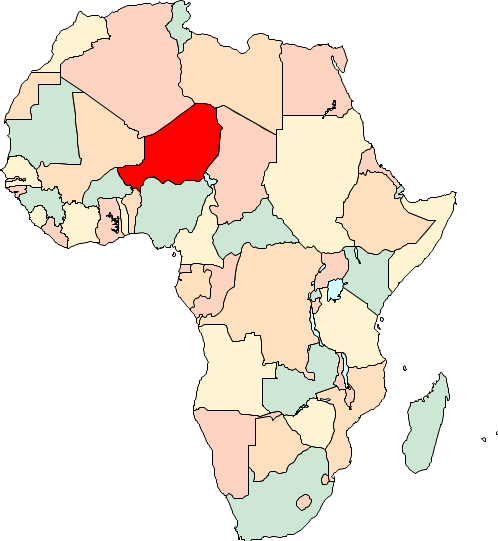
Niger in Africa
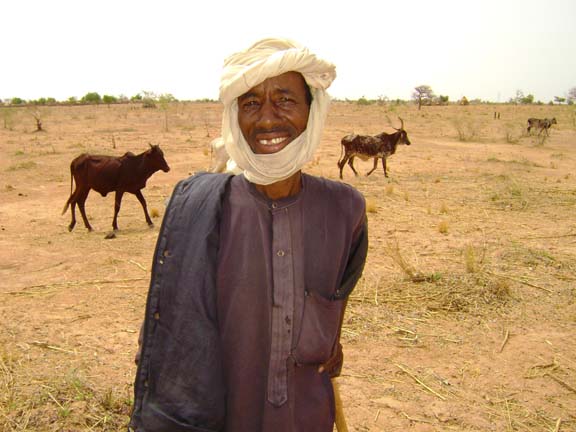
A nomadic shepherd with cattle
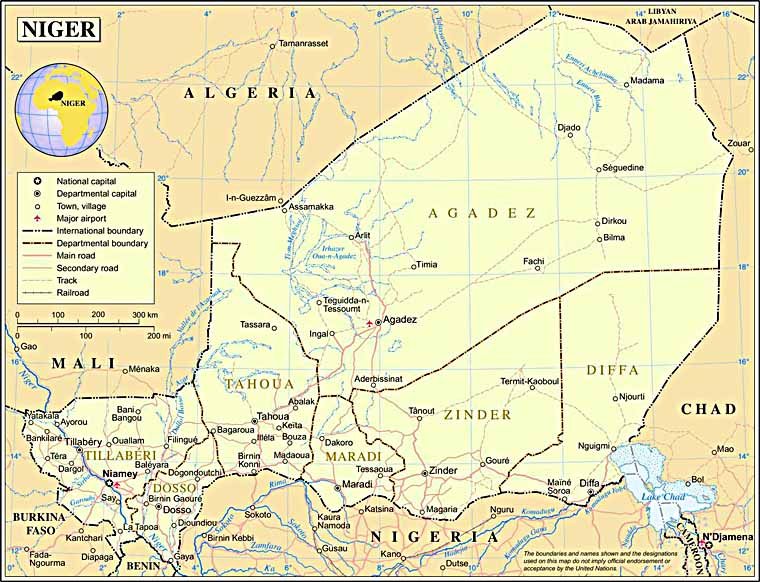
Niger political map (courtesy of Maps of the World)
The World has provided relief and aid for Niger countless times over the years to offset poor crop harvests caused by drought or insects. Niger's population growth is the highest in the world at a staggering 3.9 % annual growth (Google, 2009), and the Sahara Desert is expanding with the ongoing climate change. The United States, along with most other developed countries, is wrestling with its own fiscal problems, and there will probably be less and less of a relief effort provided to the developing nations in the future. Is there a remedy for the growing problem of food security? How can Niger learn to help itself?
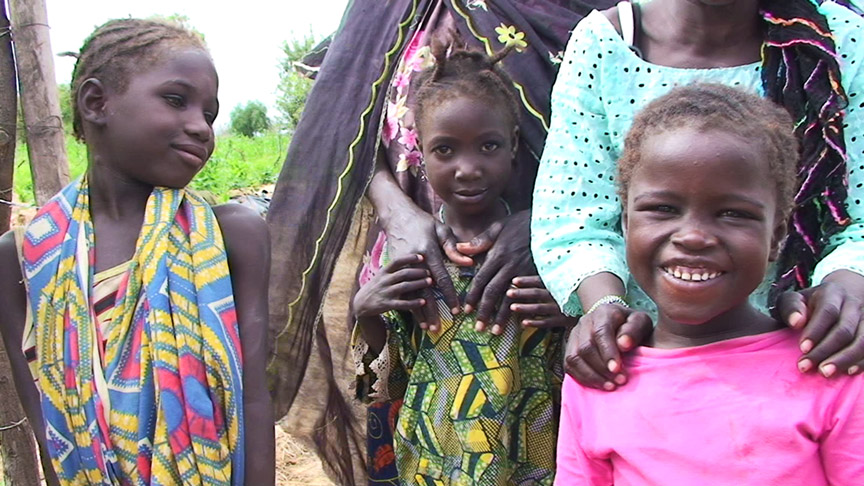
The children of Niger today will be the leaders of Niger tomorrow
Our solution seeks to build five wonderful model schools in different ethnic locations in Niger, called THE NIGER SCHOOL PROJECT. Still in the planning and funding phase (yes, this means grant writing!), these schools will host a curriculum centered around agriculture. Using this as a base, we will introduce a step-by-step process starting with small home gardens that include courtyard Simplified Hydroponic systems, which will guarantee food security. As the villager's acquire their own revenue through the marketing of vegetables, the program will expand to include solar-powered well water pumps and extensive drip irrigation systems similar to those in Israel. The arid deserts of Niger could bloom, much like the Imperial Valley's agriculture in southern California.
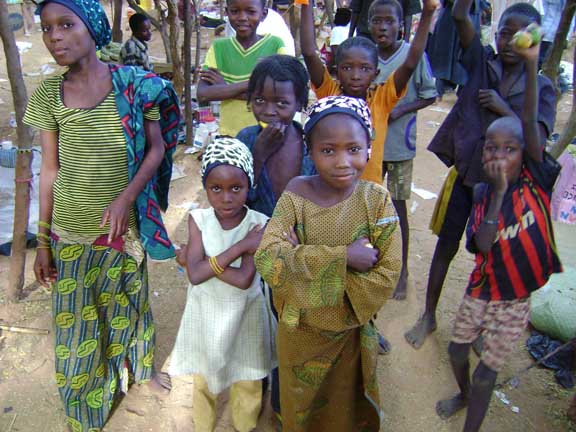
Youngsters at the weekly market near Dosso, Niger
A developed and thriving Niger is possible because currently Niger is not using even 1% of the water available in the aquifirs beneath their feet (Lennart Woltering, International Crops Research Institute for the Semi-Arid Tropics (ICRISAT), Niger). In fact, 70% of Niger has artesian well potential. If Niger was completely developed agriculturally, it could easily provide enough food to feed not only its own population, but also all of Africa (source: Prof. Dov Pasternak, (ICRISAT), Niger).
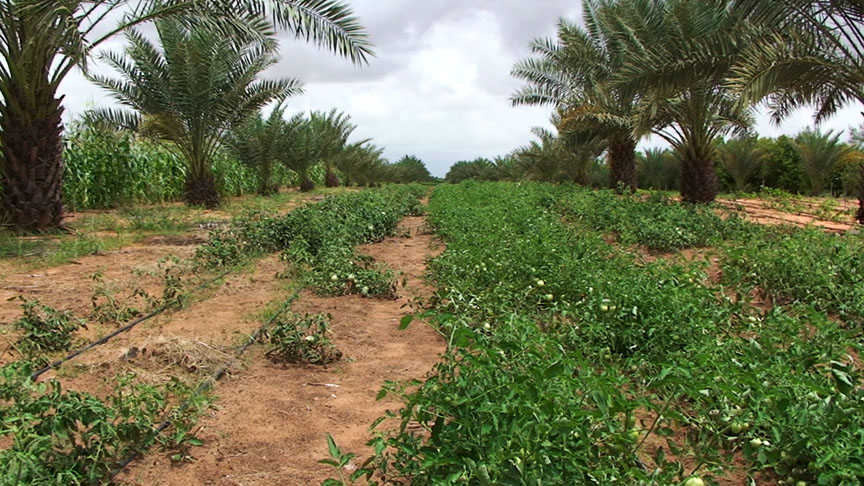
International Crops Research Institute for the Semi-Arid Tropics (ICRISAT) mixed agriculture at Sabore
We intend to include an accelerated learning tutorial program in basic education (reading, writing, math), along with some vocational training (business accounting, small engine repair, sewing with machines, etc.). The extended school grounds will feature a vegetable garden and fruit tree orchard, for hands-on experience.
Aquaculture with the indiginous Nile Tilapia will be presented in small-scale ponds to provide additional protein in the diet.
Evening classes will be available for adults or children unable to attend during the day. Solar-powered, or photovoltaic (PV) panels will provide electricity for the schools, and each school will have an accompanying water well.
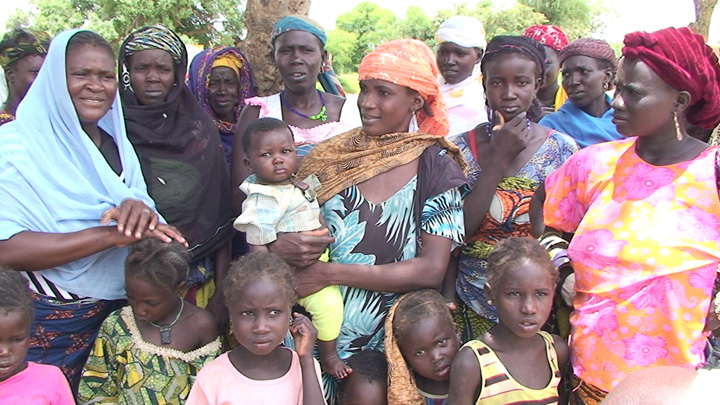
Ladies and kids of Handaga Village, near Tera, Tillabery
While French is the National Language of Niger, only 15% of the population speak the language fluently. We'll provide tutorial lessons in French through the local language, and also introduce English.
The hope is to bring about change over the course of a generation, by teaching and training the youngsters in the practical aspects of irrigated agriculture and associated skills. The nomadic pastoralist lifestyle is fading as Africa's climate shifts and population grows, and those small subsistence farmers who rely solely on the rain and the yearly millet crop need to change to crops with better market value, as well as implement irrigation and fertilization. The subsistence-grown millet crop that so much of the sub-Saharan Sahel depends upon is actually preventing progress, and every year 5% of the land used for millet is lost to erosion by wind and rain (Prof. Dov Pasternak, ICRISAT).
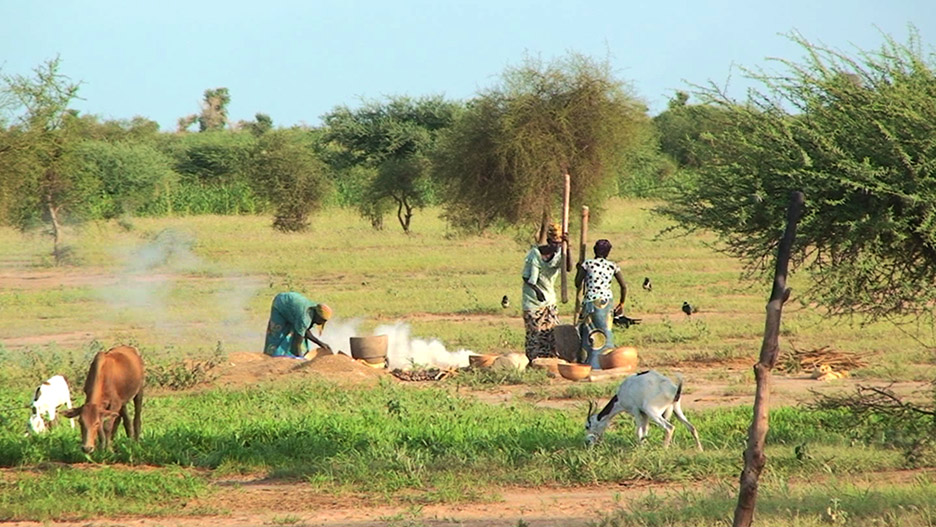
Women pounding millet to a flour/ meal during the rainy season, the landscape is briefly verdant but soon becomes desert again
After we secure funding, the Niger School Project has been approved for development and design assistance by Architects Without Borders Oregon, a wonderful group with a history of providing design for great projects, which includes schools in Ethiopia and current volunteer projects in Tanzania and Haiti. Since the US Peace Corps has a strong presence in Niger, we hope to collaborate with them, as well as many other governmental and non-governmental organizations. We will be based out of Niamey, the capitol of Niger.
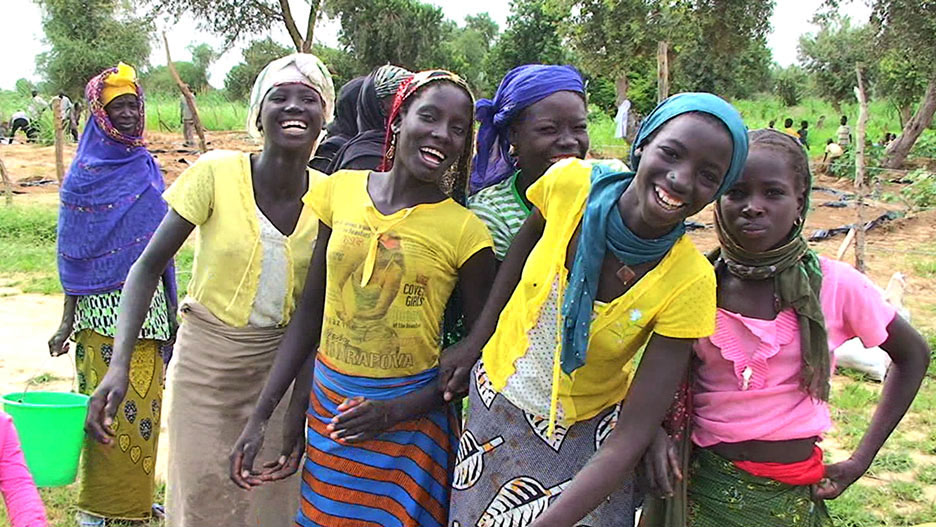
Young ladies at the village water well
As the planning phase of my Niger School Project turns into the action stage, I'll be updating this website - please revisit. There will also be a website dedicated to this project: www.alittleschoolinafrica.com
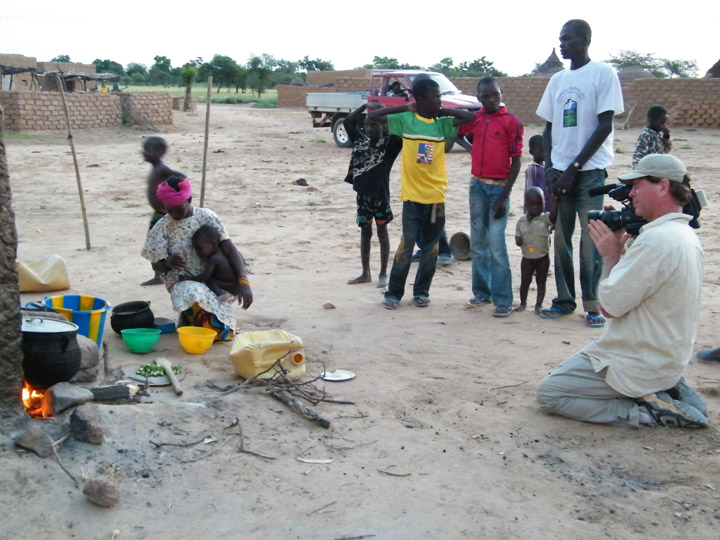
Dinner preparations in Handaga village
My involvement with Africa came about through a volunteer friend I met in Sri Lanka after the tsunami, Mervyn Church, from the United Kingdom. While recovering from a surgery, Merv decided to help a little girl named Zouera he had been supporting through a charity in a small village called Handaga in Niger. Merv decided to travel to her village, and asked me if I wanted to go; it sure seemed like a good story to shoot as a documentary.
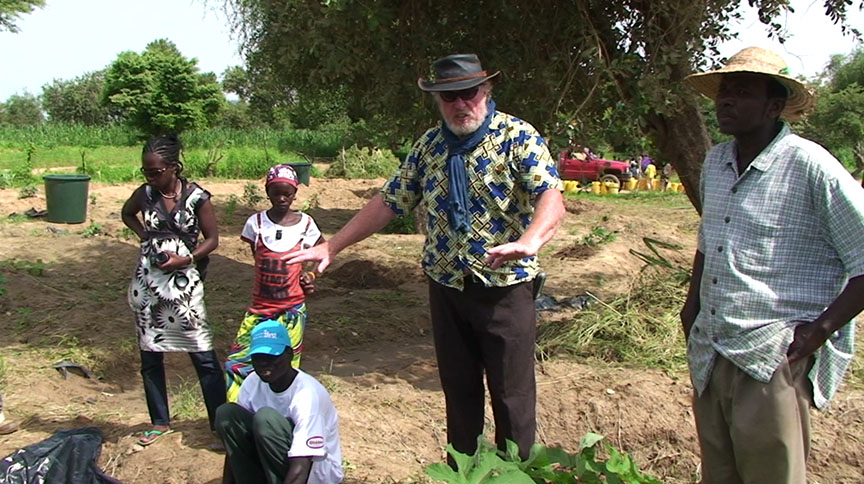
Samira Sabu (translator), Zouera, and Mervyn in the new garden area
Mervyn has visited Handaga Village seven times in the last three years, using his own money and some donations from friends to bring some famine relief and school supplies, but the real support he brought was in developing a drip irrigation garden. The villagers in this area of Niger had never had a vegetable garden outside the rainy season, and with the chief's blessing, Merv led a crew to fence and clear a half-acre of land and install reservoir barrels and drip lines.
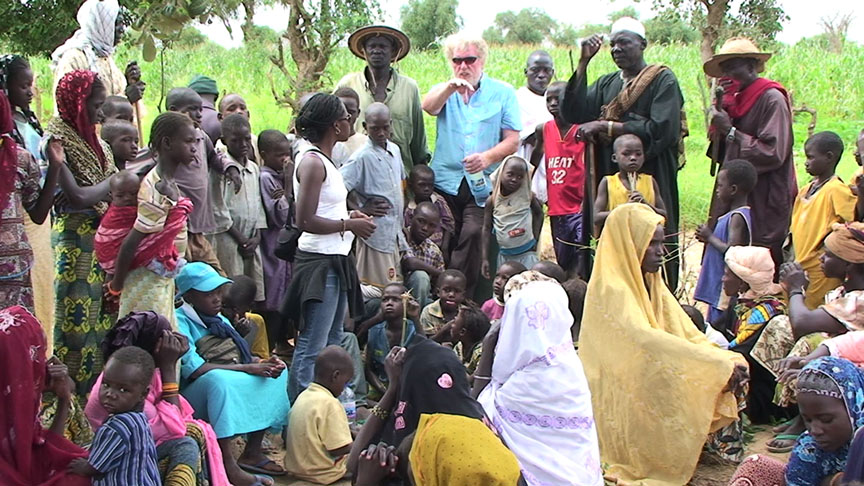
Mervyn Church, to the right Ibro the Schoolmaster (white shirt) and the Chief (dark robe, white hat)
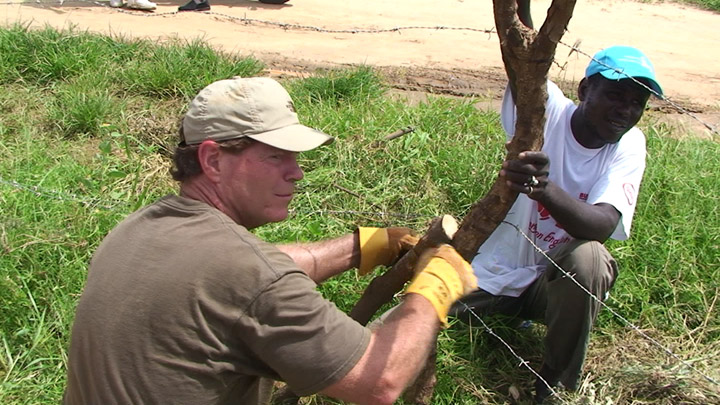
Maybe a tight fence will discourage hungry goats
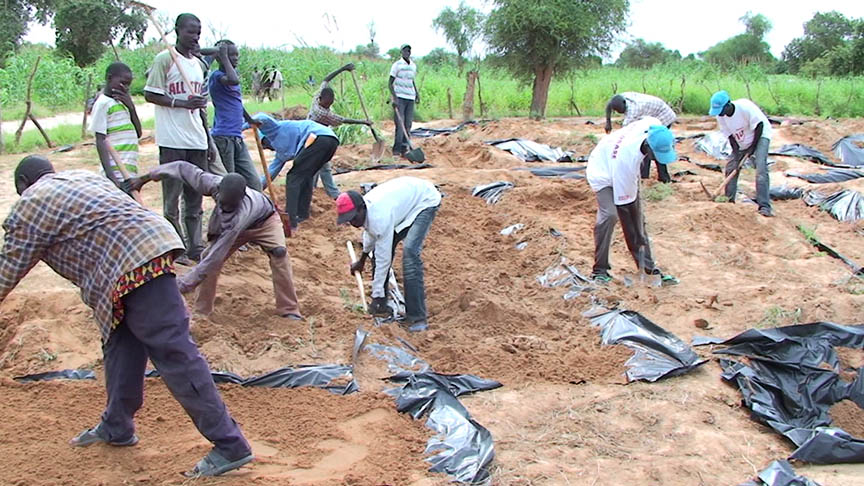
Men and boys of Handaga Village preparing water-conserving plastic lined beds in the new community garden
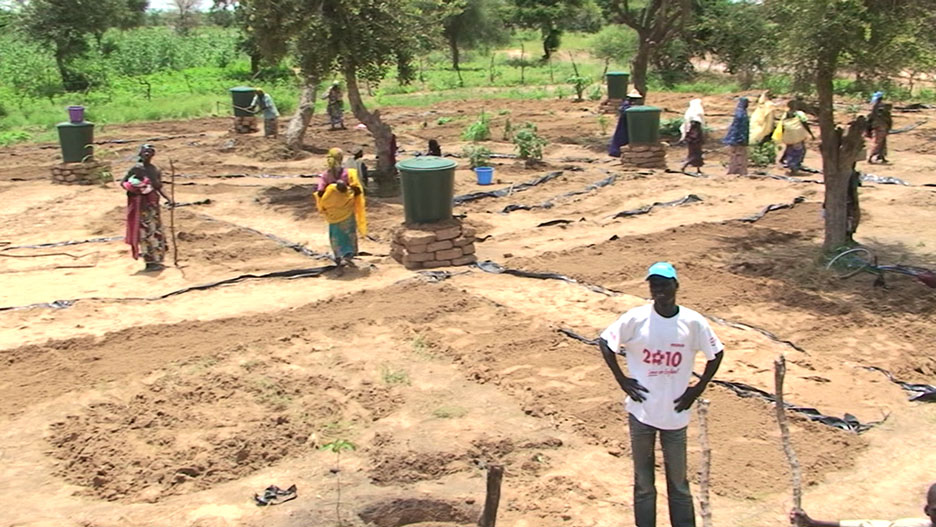
The new community garden, ready for the last few drip lines, and then for seeds
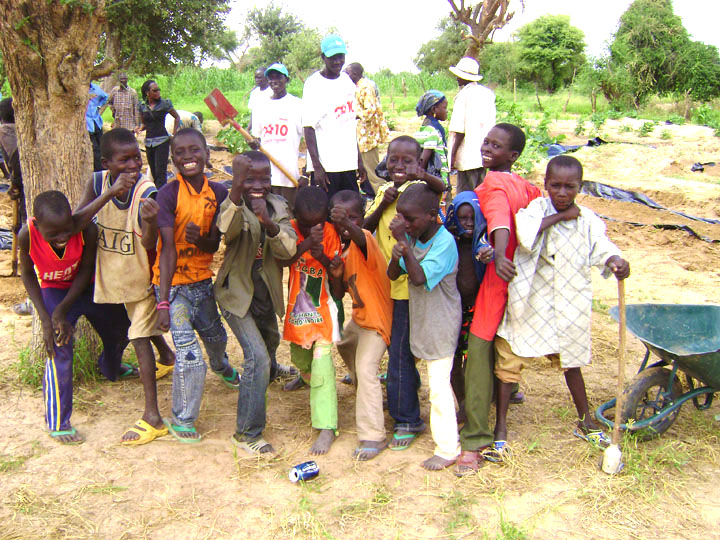
These boys really need a soccer ball... or karate lessons... but we brought them...
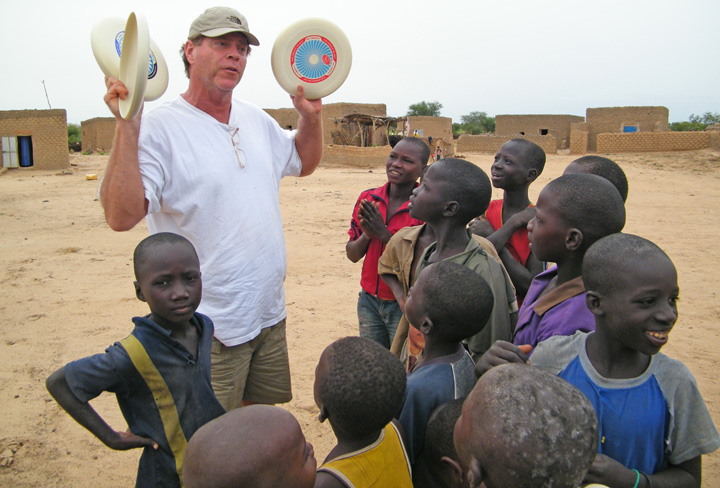
Frisbees, donated by my sister Jeannie
Our trip to Niger was for two weeks, permitting two treks out to Handaga Village. However we did manage to construct a Simplified Hydroponic grower adapted for the arid desert conditions of Niger where wood is scarce, using thick black plastic available in the capitol Niamey, red gravel and millet husks. Since it takes time to teach and implement this concept, we did not grow plants in the growers - yet. Ibro the Schoolmaster is intrigued with this simplifed hydroponics, and we'll probably introduce this into the large enclosed school courtyard.
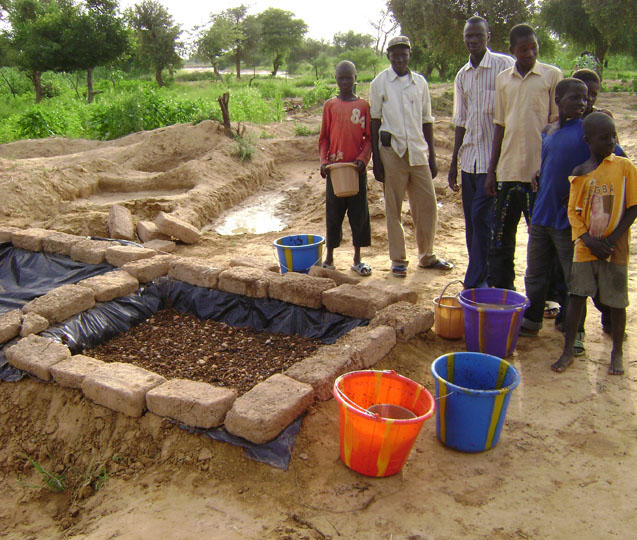
Simplified Hydroponic grower adapted for Niger, comprised of mud bricks, red gravel and millet husks
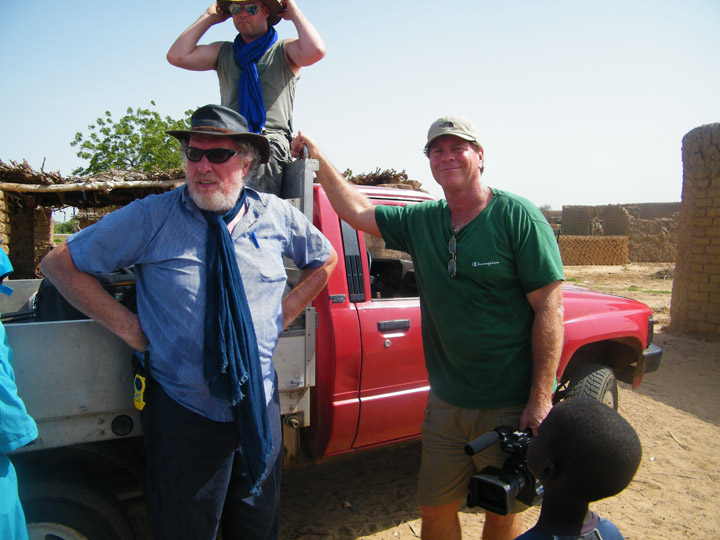
Mervyn Church, Rob Garley and Will in Handaga Village, August 2010
Every time Merv came to the village, all the people brought their sick children to him, most with malaria. Merv just loaded up the truck and took them to the nearby clinic, or in some cases, the small hospital in Tera. I wonder what a Highway Patrolman in California would think if he passed a Toyota truck with five people in the front and twenty people in the back barrelling down the road.
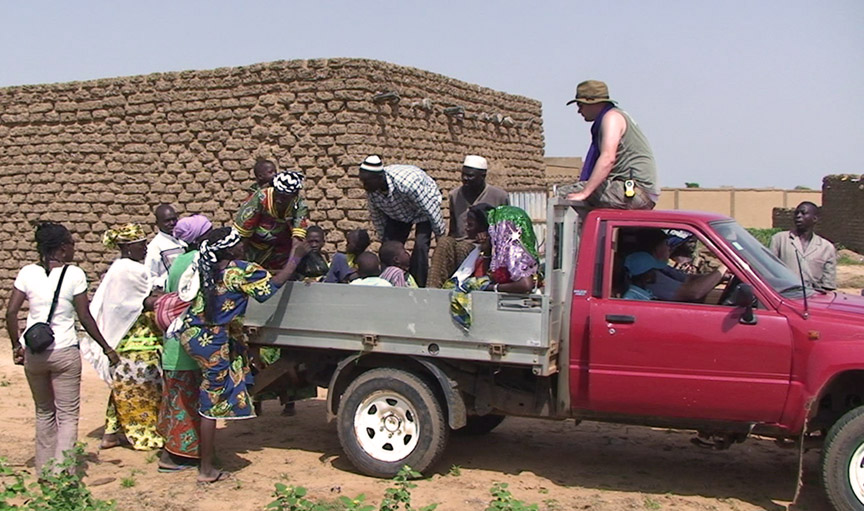
Loading the truck for a run to the clinic
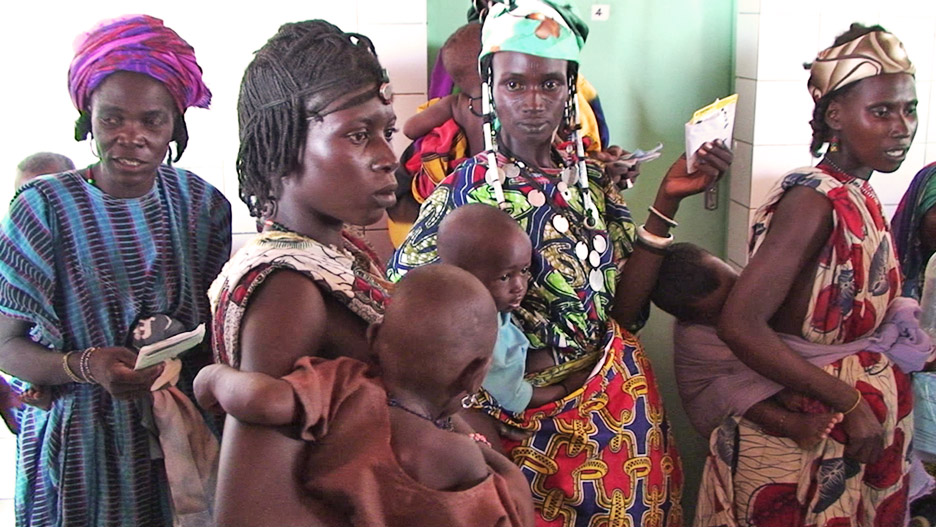
The medical clinic near Handaga village
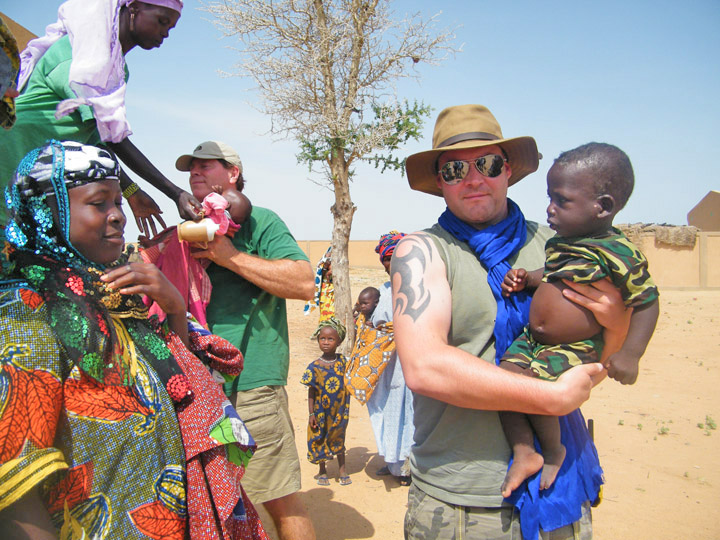
Unloading kids with malaria from the truck at the clinic, second trip today
I first travelled to Niger in April, 2009. The trip was a fact-finding mission, which developed into my Niger School Project after I met with some nice folks at our US Embassy in Niger and saw the potential to make and impact. I returned to Niger with Mervyn Church in August 2010, which was really to support Merv's garden project in Handaga. Although most of our time and efforts were directed towards Handaga, we were able to meet Professor Dov Pasternak from ICRISAT, and Dov graciously gave us a tour of his model African Market Garden one and a half hours' drive east of Niamey in the village of Tanka.
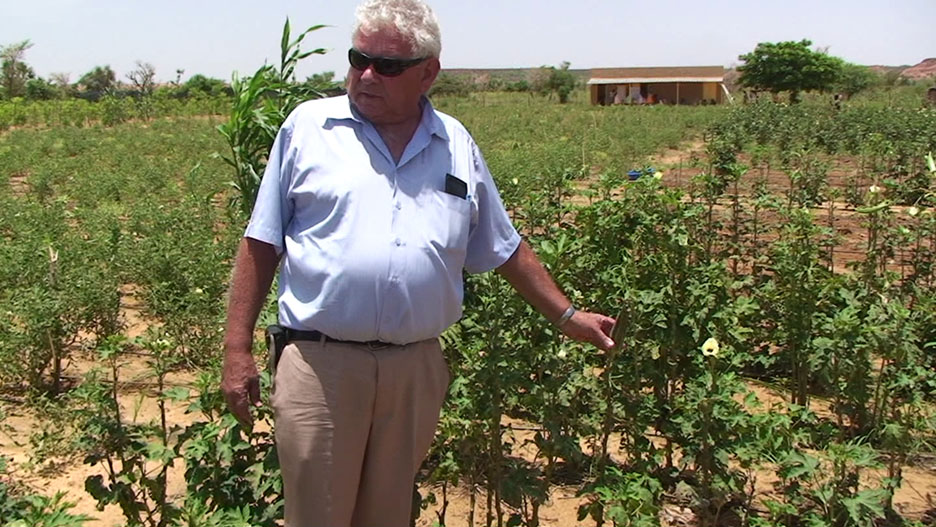
Professor Dov Pasternak, in his model African Market Garden at Tanka Village, inspects okra plants
Dov Pasternak has developed a program for kids called "Farmers of the Future," which starts with school gardens and some business skill lessons, and then expands towards larger systems with solar-powered water well pumps, reservoirs, drip irrigation and protected nursery. Dov has actually trained people to help install these systems, which are usually between 5 and 8 hectares (1 hectare = 2.47 acres) complete with a good fence around the perimeter. Our Niger School Project will enlist the Dov's help to equip each school location with a large garden, and part of the curriculum will be lessons in maintaining this African Market Garden, as well as graphting, pest control, fertilization and seed harvesting.
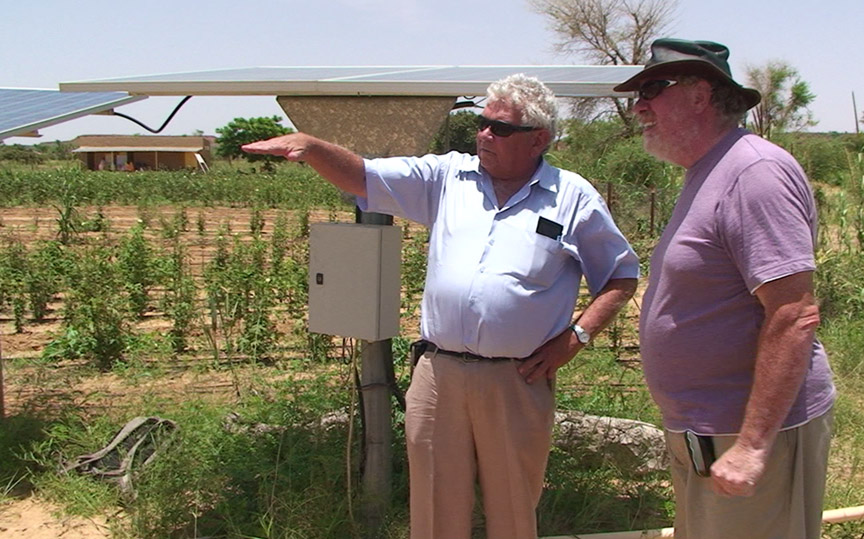
Dov and Merv with the two photovoltaic panels which power an immersion water pump at the Tanka village garden
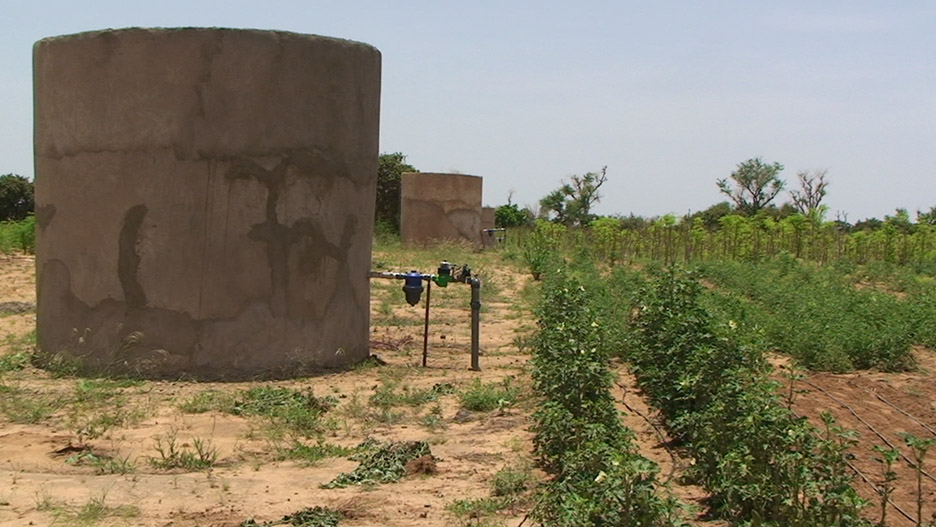
Three reservoirs are filled successively during the daytime (no batteries for the PV system!) and then a regulated passive drip irrigation
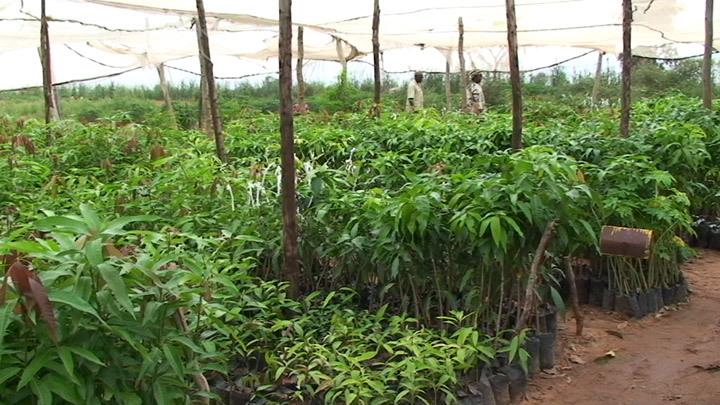
Small mango trees in the nursery at Sabore, near ICRISAT
Dov has been in Niger for nine years, and another project he's working on is actually reclaiming degraded land. This unusable land, depleted through growing millet and erosion, is redeemed by careful fertilization, water-conservative embankments called demi-lumes, and smart plant choices.
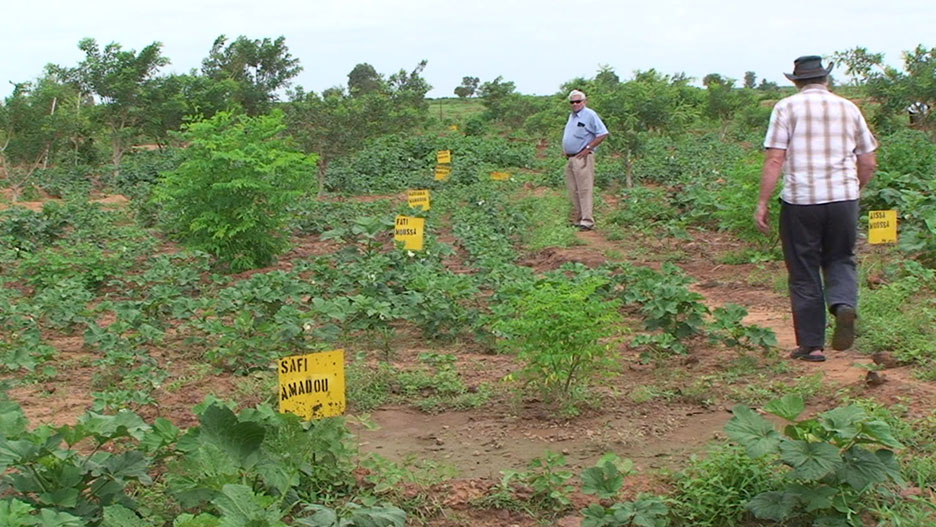
Dov's reclaimed degraded land garden, with young fruit trees and vegetable plants
The African Market Garden at Tanka Village was nine months old when we arrived with Dov. The garden is worked by 50 village ladies and led by Madame President Fati Hassan Tankarro, who also happens to be the village chief's wife. Each of these ladies has earned $1,200. US in this short time, and the garden is far from being completely developed. In a country where the average villager's yearly income is one of the lowest in the world, this is an amazing achievement. These ladies devote much of their earnings to their children's education and school supplies.
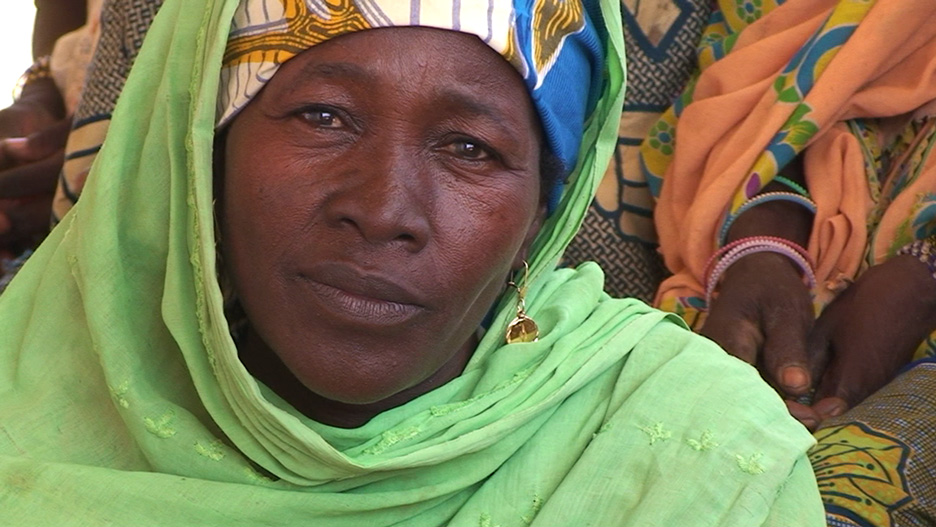
The President of the African Market Garden at Tankara Village, Madame Fatih Hassan Tankarro
A LITTLE SCHOOL IN AFRICA will be a documentary movie reporting examples of transformation towards strong self-sufficiency in a nation of wonderful people.
2006
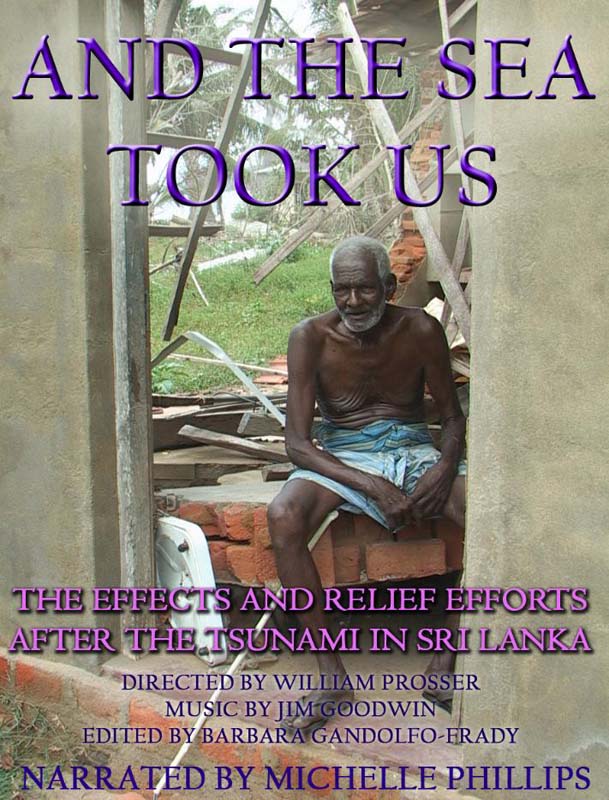
I volunteered to help with the relief effort after the tsunami of December 26, 2004. Through a friend in Los Angeles, Jan Smith, I was able to join up with Ray Dingle of Australia, who owns property in the hard-hit Southern tip of Sri Lanka. After the tsunami, Ray set up a fund to help the villagers in the area, called The Marwella Village Relief Fund (MVRF). Marwella lies between Matara and Tangalle, and the primary vocation of the villagers there is fishing.
I arrived in the Marwella area February 1, just over a month after the tsunami struck. The emergency phase of the disaster was over, and most displaced people were situated in makeshift "camps," comprised of tents and other temporary shelters. Food and water were in demand, and through various governmental (Sri Lanka) and non-governmental organizations (N.G.O.'s from Sri Lanka and many foreign countries), these needs were being met. MVRF focused mainly on getting the fishermen back to work, so the villagers could start to rebuild their lives.
The Sri Lankan Navy, particularly the training base in Tangalle and Commander Jagath Mutubandara, gave enormous support and aid to MVRF. Cmdr Jagath brought Navy mechanics to repair outboard motors damaged by salt-water immersion, and Raymond supplied the parts, travelling to Matara in a Took Took most days. In the end, 53 outboard motors were repaired, and two brand new motors were purchased to replace two lost motors.
Adopt Sri Lanka had a program to replace completely damaged boats and fix repairable boats; I set up a small boatyard to repair boats as well. I also began to replace some of the fishing gear, at least light tackle, so the men could begin fishing. Raymond's MVRF kindly provided accommodations for me, at an operating resort between Tangalle and Marwella, called The Palm Paradise Cabanas (palmparadisecabanas.com). Dr. Manfred Meinike of Germany built this beautiful guest house 25 years ago, and used his facility as a staging area for the distribution of relief supplies to the villagers in the area. MVRF also allocated petty cash for my use in purchasing tackle, fiberglass and resin, etc. I brought carpentry and masonry tools from California, and we set up a workshop so the villagers could repair their own boats, and later, their homes.
The government implemented a "100 meter setback from the sea" rule, which they hoped would protect villagers from another tsunami disaster, and there was much discussion about where to relocate the displaced people and build permanent housing. In the meantime, we also provided some necessities for the people in shelters such as gas cookers, gas bottles, tables and mattresses. The Sri Lanka Navy gave us mosquito nets and lanterns to distribute. I ran a beach cleanup operation, with 36 workers, and the Navy helped with officers to help supervise. G.T.Z. (German Development Cooperation), a large N.G.O. in Sri Lanka, reimbursed MVRF for the wages to clean the village beach area.
Many wonderful people from the U.K., Germany, France, Netherlands, Japan, Korea, Australia, Belgium and Italy came and worked as volunteers, and many donated money or food or clothing to the villagers. One lady from the U.K., Lyn Watson, came and worked with MVRF, and helped the traumatized kids with art classes. I also set up a painting class, and MVRF supplied oil paints and brushes; the kids (and adults) had never used oil paints and they were actually quite good at it - fast learners. A small wistful distraction for these people, who had lost loved-ones and homes.
Between Hambantota and Matara approximately 6,000 people were killed or missing from the tsunami. Lyn Watson also set about surveying each family door-to-door in the entire area, 4 villages and a large camp, to complete a "Needs Assessment" which all the N.G.O.'s in the area could access, through G.T.Z. In my free time, I started a survey for nets, which was the principle method of fishing.
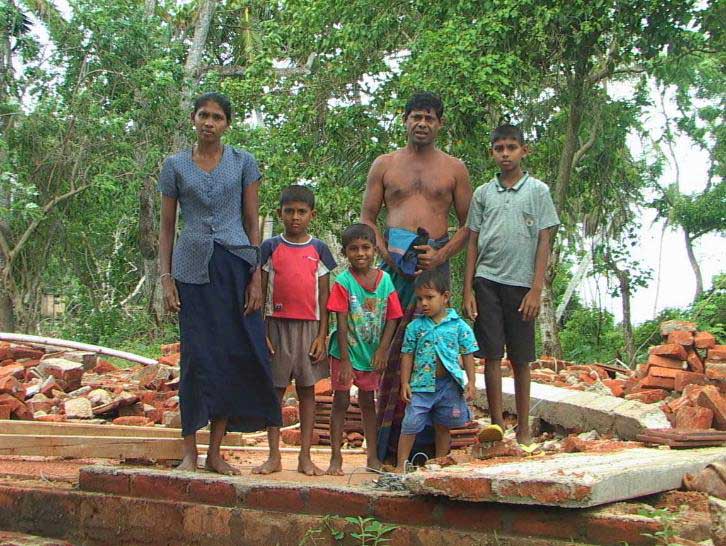
Jayasiri, Kumari and their children stand in the ruins of their home after the tsunami in Sri Lanka
I stayed in Sri Lanka for nearly 5 months, but right before I left, LTU (Lufthansa Airlines) through Berti and Maria Rumpel, kindly granted me 35,000 Euros for the purchase of 95 fishing nets; 73 were distributed just after I returned home to the U.S.
In my spare time between work, I shot video of the beautiful people of Sri Lanka, as well as the devastation caused by the tsunami. I went to Sri Lanka as an aid worker, so my priorities were with the Relief Effort; there were incredible shots I missed because I was busy working, which is really my one regret.
After returning to the U.S., I took my video footage to show a friend who is an editor, Barbara Gandolfo-Frady. Barbara thought we had good footage for a documentary, and she came out to Californai from North Carolina to help edit. We put together a movie called AND THE SEA TOOK US, with Michelle Phillips very generously donating a compelling narration, and Jim Goodwin of Eggchair Music in Hollywood (eggchairmusic.com) donating the writing and performing of his very cool music.
AND THE SEA TOOK US chronicles the effects of the tsunami on the local villagers, and the relief efforts from all the generous foreign aid workers. A rough cut of 114 minutes version of our movie premiered in April 2006 at the Docufest Atlanta Film Festival, and we won the "Best Educational Documentary" award. The final edited version at 65 minutes of AND THE SEA TOOK US was an official selection in the River's Edge International Film Festival in Paducah, Kentucky, in August 2006. This completed version of the movie was also shown at the Fort Lauderdale International Film Festival in 2006, which ran from October 20 to November 12. As producer/director, I won The Spirit of Independence Award, and The Spirit of Independence Award was also presented to Michelle Phillips for her first narration.
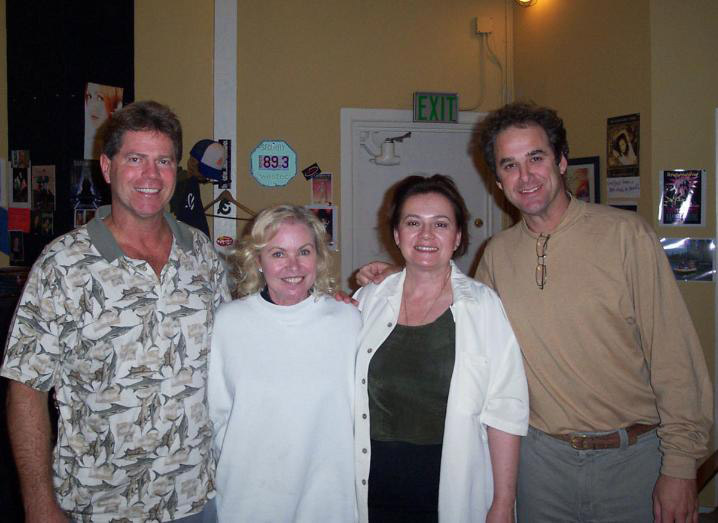
l-r: Will Prosser, Michelle Phillips, Barbara Gandolfo-Frady, and Jim Goodwin at Eggchair Music Studio, Hollywood, September 2005